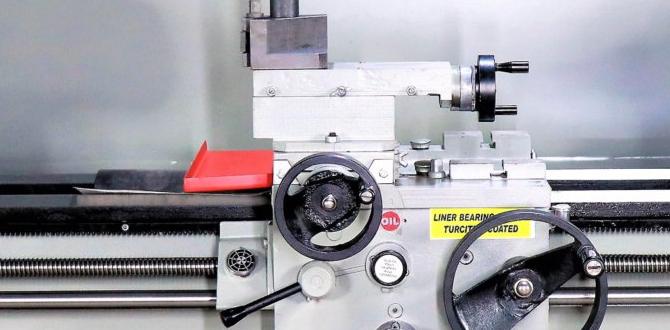Yes, a TiAlN ball nose end mill with a 35-degree helix angle is an excellent choice for roughing cast iron. Its durable coating handles the heat and abrasion inherent in cast iron machining, while the ball nose shape is versatile for complex contours and efficient material removal.
Hey makers, Daniel Bates here from Lathe Hub! Ever stare at a block of tough material, like cast iron, and wonder about the best tool for getting the bulk of it out quickly and cleanly? You know, the roughing part before we get to all the fine details. It can be a bit daunting, especially when you hear terms like “helix angle” and “coating,” but don’t worry! Today, we’re diving into one of the most effective tools for this job: the TiAlN ball nose end mill with a 35-degree helix angle. We’ll break down exactly why this tool is a workhorse, how to use it safely, and what makes it so good for materials like cast iron. Stick around, and you’ll be tackling those roughing jobs with confidence in no time!
Why a 35-Degree TiAlN Ball Nose End Mill Rocks for Roughing
When you’re looking to remove a lot of material quickly and efficiently, especially from challenging metals like cast iron, the right tool makes all the difference. The combination of a ball nose shape, a 35-degree helix angle, and a TiAlN coating on an end mill isn’t just a random selection of features; it’s a carefully designed package that excels at roughing operations. Let’s break down why each of these elements is so important.
The Ball Nose Advantage
First up, the “ball nose.” Imagine the tip of the cutting tool is perfectly rounded, like the tip of a ball. This is crucial for a few reasons:
- Versatility in Contours: A ball nose end mill is fantastic for creating curved surfaces, fillets, and complex 3D shapes. Even when roughing, you might be working on a part that will have these features. The ball shape helps maintain a consistent radius as you mill.
- Smooth Material Removal: Unlike a square-shouldered end mill that can create sharp corners (which can be stress points or require extra finishing), the ball nose glides through the material, leaving a more rounded profile. This can also help in distributing cutting forces more evenly.
- Accessibility: The rounded tip can get into tighter spots and corners where a flat-bottomed end mill might struggle, making it ideal for getting close to features without accidentally damaging them.
The Magic of the 35-Degree Helix Angle
Now, let’s talk about the “35-degree helix angle.” This refers to the angle at which the cutting flutes spiral around the body of the end mill. It might seem like a small detail, but it has a big impact:
- Balancing Chip Load and Tool Strength: A common helix angle for general-purpose end mills is 30 degrees. Increasing it to 35 degrees offers a bit more aggressive cutting action. For roughing, a higher helix angle generally allows for a slightly larger chip load (the amount of material removed by each tooth per revolution), which means faster material removal. At the same time, it helps to reduce the cutting forces and vibration.
- Improved Surface Finish (for Roughing): While it’s a roughing tool, a well-chosen helix angle can still contribute to a smoother-than-expected finish. The steeper angle helps to shear the material more effectively, leading to less tearing and a cleaner cut surface, which translates to less work later on.
- Reduced Chatter: Vibration, or chatter, is the enemy of good machining. The 35-degree helix angle, combined with other design features, can help to dampen vibrations, leading to a more stable cut and less noise. This is especially important when you’re pushing the tool to remove material aggressively.
TiAlN Coating: The Toughest Skin
The “TiAlN” stands for Titanium Aluminum Nitride. This is a PVD (Physical Vapor Deposition) coating that is applied to the surface of the end mill. Think of it as a super-tough, heat-resistant jacket for your cutting tool:
- Exceptional Hardness: TiAlN is incredibly hard, which means it resists wear and abrasion. This is vital when machining tough materials like cast iron, which can be abrasive and wear down tools quickly.
- High-Temperature Resistance: Machining generates heat. Lots of it. TiAlN has excellent thermal stability and creates a barrier that protects the tool’s core from excessive heat. This allows you to machine at higher speeds and feed rates without the tool softening or degrading.
- Reduced Friction: The coating also lowers friction between the cutting edge and the workpiece. This means less heat buildup, longer tool life, and cleaner chip evacuation.
- Ideal for Ferrous Materials: While TiAlN can be used on a variety of materials, it shines particularly brightly when machining ferrous materials like steels and, importantly for our discussion, cast iron. It forms a stable oxide layer at high temperatures, further protecting the tool.
Putting It All Together for Cast Iron Roughing
So, when you combine these three elements – the versatile ball nose, the efficient 35-degree helix, and the durable TiAlN coating – you get a tool that’s perfectly suited for the demands of roughing cast iron. It can chew through material quickly, handle the heat that cast iron generates, and leave you with a surface that’s ready for the next stage of machining, all while extending the life of your valuable tooling.
When to Choose This Tool: Specific Applications
The TiAlN ball nose end mill with a 35-degree helix angle isn’t just a great general-purpose rougher; it’s particularly well-suited for certain types of machining tasks, especially when you’re working with materials like cast iron. Understanding these specific applications will help you leverage this tool’s strengths and get the most out of your machining time and effort.
Roughing Complex Contours and Freeform Surfaces
If you’re machining parts with curved surfaces, such as those found in engine blocks, impellers, or artistic sculptures, a ball nose end mill is almost a necessity. The 35-degree helix angle combined with the TiAlN coating makes it ideal for the roughing phase of these jobs:
- 3D Machining: For parts that require multi-axis machining to create intricate 3D shapes, this end mill excels. It can efficiently remove material while following the complex contours, leaving behind a roughed-out shape that requires less intensive finishing passes.
- Mold and Die Making: The creation of molds and dies often involves sculpting complex cavity shapes. This tool is perfect for the initial material removal in these applications, rapidly shaping the negative space.
Efficient Material Removal in Cast Iron
Cast iron is a popular material for many applications due to its machinability, damping properties, and cost-effectiveness. However, it can still be abrasive and generate significant heat:
- High Material Removal Rates (MRR): The combination of the helix angle and the tough coating allows for higher feed rates and potentially deeper cuts compared to less robust tools. This means you can remove material much faster, saving significant time on larger parts or when working with large volumes of material.
- Tool Longevity: The TiAlN coating is specifically designed to withstand the abrasive nature and heat generated when cutting ferrous materials like cast iron. This allows the tool to last much longer, reducing the frequency of tool changes and associated downtime.
- Reduced Heat Buildup: Cast iron can be tricky if it overheats, leading to poor surface finishes and increased tool wear. The performance of TiAlN at high temperatures helps manage this heat, leading to a more stable cutting process.
Working with Non-Ferrous Materials (with Caution)
While this specific combination is optimized for cast iron and other ferrous materials, it can also be used for roughing certain non-ferrous materials. However, it’s important to note that:
- Aluminum and Plastics: For softer materials like aluminum or plastics, a plain uncoated or a TiCN (Titanium Carbonitride) coated end mill designed for non-ferrous metals is often preferred. These materials tend to “gum up” or “chip weld” in the flutes of tools designed for harder, hotter-cutting materials. If using this TiAlN tool on aluminum, you’ll likely need to run it at lower speeds and feeds, and excellent chip evacuation is critical to prevent buildup.
- Consider Alternatives: If your primary work is with aluminum, you might find a dedicated aluminum end mill to be more efficient and produce a better finish. The TiAlN coating, while tough, can sometimes be too hard and cause issues with softer, gummier materials.
When NOT to Use This Tool (For Best Results)
Even the best tools have their limitations and specific use cases. For this particular end mill, it’s good to know when to reach for something else:
- High-Speed Steel (HSS) Work: This tool is designed for carbide or high-speed steel workpieces. For softer materials like certain woods or plastics, you would need a different type of end mill.
- Finishing Passes: While the 35-degree helix can provide a decent roughing finish, it’s generally not precise enough for critical finishing operations where tight tolerances and mirror-like surfaces are required. You’d typically switch to a finishing end mill with a smaller step-over and potentially a different geometry for final passes.
- Drilling or Slotting Work: While a ball nose end mill can perform slotting operations, dedicated slotting end mills are designed for straight cuts and often offer better rigidity and chip control for that specific task. It’s not designed for drilling operations from solid.
Understanding End Mill Specifications: A Quick Guide
Navigating the world of end mills can feel like learning a new language. When you’re looking at a TiAlN ball nose end mill with a 35-degree helix angle, there are a few key specifications you’ll want to understand. These details help you choose the right tool for your specific job and machine.
Key Specifications to Look For:
- Diameter: The overall cutting diameter of the end mill. This is usually the first specification people look for. Common sizes include 1/4″, 1/2″, 3/4″, and 1″.
- Number of Flutes: This refers to the number of cutting edges. For roughing, especially in tougher materials like cast iron, 2 or 3 flutes are common. More flutes (4 or more) are generally better for finishing. The extra space between flutes (gullets) on a 2- or 3-flute roughing end mill allows for better chip evacuation, which is critical for high material removal rates.
- Helix Angle: As we’ve discussed, this is the spiral angle of the cutting edges. 35 degrees is excellent for roughing, offering a good balance of aggressive cutting and chip control.
- Coating: TiAlN (Titanium Aluminum Nitride) is brilliant for high-temperature applications and ferrous materials like cast iron. Other coatings exist (like TiN, TiCN, AlTiN) for different materials and applications.
- Material of the End Mill: Most high-performance end mills are made from solid carbide. Carbide offers superior hardness and rigidity compared to High-Speed Steel (HSS), allowing for higher cutting speeds and longer tool life.
- Shank Diameter: This is the diameter of the part of the end mill that is held by the collet or tool holder. It should match your machine’s tooling capacity.
- Overall Length & Cutting Length: These dimensions tell you how far the end mill extends from the collet and how much of that length is actually used for cutting. Shorter lengths generally mean more rigidity.
- Corner Radius (for Ball Nose): For a ball nose, the “radius” often refers to the radius of the sphere at the tip. A 1/2″ ball nose end mill will have a 1/4″ corner radius, meaning the tip is a perfect hemisphere with a 1/4″ radius. This half-diameter is a critical specification for determining the concave radius it can cut.
Example Specification Table:
Let’s look at a hypothetical example of what you might find on a tool manufacturer’s website or packaging for a TiAlN 35-degree ball nose end mill:
| Specification | Value | Why it Matters for Roughing Cast Iron |
|---|---|---|
| Diameter | 0.500″ (12.7mm) | Larger diameters generally allow for deeper cuts and higher material removal rates. |
| Number of Flutes | 3 | Good balance for roughing in tough materials like cast iron, allowing for aggressive cuts while managing chips. |
| Helix Angle | 35 Degrees | Optimized for aggressive material removal and reduced cutting forces in ferrous materials. |
| Coating | TiAlN | Provides exceptional hardness and heat resistance, crucial for cast iron’s abrasiveness and thermal properties. |
| End Mill Material | Solid Carbide | Offers superior rigidity and wear resistance compared to HSS, essential for high-performance roughing. |
| Shank Diameter | 0.500″ (12.7mm) | Ensures compatibility with standard tool holders and collets. |
| Nose Radius (Ball Nose) | 0.250″ (6.35mm) | Defines the concave fillet radius the tool can create and influences surface finish during contour roughing. |
| Overall Length | 3.00″ (76.2mm) | Determines reach; shorter lengths offer more rigidity. |
As you can see, each specification plays a role. For roughing cast iron, prioritizing a higher flute count (2 or 3), a robust coating like TiAlN, and solid carbide construction will serve you well.
Setting Up for Success: Machine Speed, Feed Rate, and Depth of Cut
Getting the most out of your TiAlN ball nose end mill for roughing cast iron isn’t just about picking the right tool; it’s also about setting up your machine correctly. This involves finding the sweet spot for spindle speed, feed rate, and depth of cut. These parameters are interconnected and depend on your specific machine’s power, rigidity, fixturing, and the exact alloy of cast iron you’re working with.
Understanding the Basics
Before we dive into numbers, let’s quickly define what these terms mean:
- Spindle Speed (RPM): How fast the end mill spins, measured in revolutions per minute.
- Feed Rate (IPM or mm/min): How quickly the tool moves through the material. For end mills, this is often expressed as “inches per minute” (IPM) or “millimeters per minute” (mm/min).
- Depth of Cut (DOC – axial): How deep the end mill cuts into the material along its axis.
- Width of Cut (WOC – radial): How much of the tool’s diameter engages the material horizontally. For ball nose end mills in contouring, this is often controlled by the step-over distance.
Starting Points for Cast Iron Roughing
These are general guidelines. Always start conservatively and listen to your machine and tool. A good rule of thumb is to always aim for chip evacuation rather than trying to melt the material.
1. Spindle Speed (RPM)
A good starting point for solid carbide end mills in cast iron is usually in the range of 30-80 Surface Feet per Minute (SFM) or 10-25 meters per minute (m/min). To convert this to RPM, you’ll use the formula:
RPM = (SFM x 12) / Diameter_in_inches
or
RPM = (m/min x 1000) / (Diameter_in_mm x π)
Example: For a 1/2″ diameter end mill, using 50 SFM:
RPM = (50 x 12) / 0.500 = 1200 RPM
For a 12mm diameter end mill, using 15 m/min:
RPM = (15 x 1000) / (12 x 3.14159) ≈ 398 RPM
Key takeaway: Start at the lower end of the recommended SFM/m/min range, especially if you’re unsure about your machine’s rigidity or fixturing.
2. Feed Rate (IPM / mm/min)
The feed rate is determined







